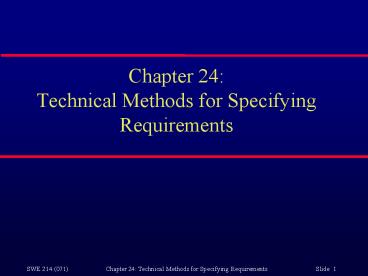Chapter 24: Technical Methods for Specifying Requirements - PowerPoint PPT Presentation
1 / 12
Title:
Chapter 24: Technical Methods for Specifying Requirements
Description:
SWE 214 (071) Chapter 24: Technical Methods for Specifying Requirements ... An attempt to combine the informality of natural language with the strict syntax ... – PowerPoint PPT presentation
Number of Views:52
Avg rating:3.0/5.0
Title: Chapter 24: Technical Methods for Specifying Requirements
1
Chapter 24Technical Methods for Specifying
Requirements
2
Objectives
- To introduce some technical methods for
specifying software requirements. - Pseudocode
- Finite state machines
- Decision tables and decision trees
- Activity diagrams (flowcharts)
- Entity-relationship models
3
Introduction
- There are cases in which the ambiguity of natural
language is simply not tolerable - Examples when the requirements deal with
life-and-death issues or when the erroneous
behavior of a system could have extreme financial
or legal consequences. - If the description of the requirement is too
complex for natural language and if you cannot
afford to have the specification misunderstood,
you should consider writing or augmenting that
portion of the requirements set with a "technical
methods" approach.
4
Technical Specification Methods
- Pseudocode
- Finite state machines
- Decision tables and decision trees
- Activity diagrams (flowcharts)
- Entity-relationship models
5
Pseudocode
- Pseudocode is a "quasi" programming language
- An attempt to combine the informality of natural
language with the strict syntax and control
structures of a programming language. - It usually consists of combinations of
- Imperative sentences with a single verb and a
single object - A limited set, typically not more than 4050, of
"action-oriented" verbs from which the sentences
must be constructed - Decisions represented with a formal IF-ELSE-ENDIF
structure - Iterative activities represented with DO-WHILE or
FOR-NEXT structures
6
Example of Pseudocode
- A pseudocode specification of an algorithm for
calculating deferred-service revenue earned for
any month is - Set SUM(x)0
- FOR each customer X
- IF customer purchased paid support
- AND ((Current month) gt (2 months after ship
date)) - AND ((Current month) lt (14 months after ship
date)) - THEN Sum(X)Sum(X) (amount customer paid)/12
- END
7
Finite State Machines
- Example of a state transition diagram
- The natural language expression "the other light
shall flash every 1 second" was ambiguous. - The above state transition diagram is not
ambiguous since it illustrates that duty cycle B
was indeed the right choice.
8
Finite State Machines (Contd)
- Example of a State Transition Matrix for an
On/Off Counting Device - What happens if the user presses the On switch
and the device is already on? Answer Nothing. - What happens if both bulbs are burned out?
Answer The device powers itself off.
9
Decision Tables and Decision Trees
- It's common to see a requirement that deals with
a combination of inputs different combinations
of those inputs lead to different behaviors or
outputs.
10
Activity Diagrams
- An activity diagram is a essentially a flowchart,
showing flow of control from activity to activity.
11
Entity-Relationship Models
- If the requirements within a set involve a
description of the structure and relationships
among data within the system, it's often
convenient to represent that information in an
entity-relationship diagram (ERD).
12
Key Points
- Technical methods for specifying requirements are
appropriate when the requirement description is
too complex for natural language or if you cannot
afford to have the specification misunderstood. - Technical methods include pseudocode, finite
state machines, decision trees, activity
diagrams, entity-relationship models, and many
others.






























